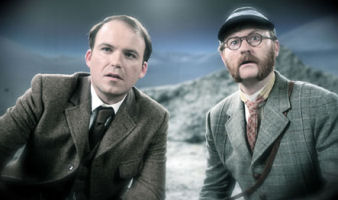When I wonder about the lives of TV characters after their shows have ended, the ones who fascinate me the most are the children. So much potential never to be realized on screen. (I would think the Weeping Angels would feast their way through orphanages and day care centers!)
There's Little Ricky ('I Love Lucy'), Will Robinson ('Lost In Space'), Corey Baker ('Julia'), and David & Mary Lou Baxter ('The Mary Tyler Moore Show'). Whatever became of them in Toobworld once they grew up? (I know my blogging buddy Ivan Shreve would love to find out if "Idiot Boy Mike" Jones from 'Mayberry R.F.D.' was a Darwin Award winner!)
With the slow aging process of Martians, would Andromeda, the nephew of 'My Favorite Martian' still be looking like a teenager?
Sometimes we get the chance to see how they turned out - 'The Brady Bunch' keeps coming back, and there have been updates on Mark McCain, Ritchie Petrie, Opie Taylor, Beaver Cleaver, and Anthony Fremont ('The Twilight Zone' - "It's A Good Life").
It's the one-shot performances by child actors as guest stars in TV series that interest me the most, mainly because there's so much potential there for supposition. And with a recent repeat of 'Perry Mason' on Me-TV, I found a great candidate!
"The Case Of The Missing Button" concerned the tug of war between the divorced parents of little Button Blake, who was the heir to a $4 million dollar inheritance from her grandfather. If I recall it correctly, she would gain control of the family pharmaceutical empire when she came of age. Eventually a blackmailer was found murdered and Button's father was arrested for the crime.
The main reason I found Button Blake to be an interesting candidate for such "wish-craft" about her life as a grown-up was her name. "Button" must be a nickname, so her first name could be anything. And if she married once she got older, then she wouldn't have to be known by the last name of "Blake", either. That left a wide-open field of candidates to consider from other TV shows to be Button Blake as a grown-up.
That 'Perry Mason' episode was broadcast in 1964, but that doesn't necessarily mean that's when it took place. Each one hour episode of 'Perry Mason' contained long time spans from the actual murder to the preliminary hearings, so several episodes could conceivably overlap each other.
But if the "Missing Button" episode did take place in 1964, then Button was born in 1960. (She was mentioned as being four years old in the episode.) However, the actress playing the role, Claire Wilcox, was older by five years - making her the same age as I am now. Nevertheless, if I was to consider someone to play Button as a grown-up recastaway, I'd stick with those actresses who were also born in 1960.
I found a lot of candidates - characters played by Jane Lynch, Tracy Pollan, Leslie Hendryx, even Tilda Swinton. But I decided to go with Mary Mara, and not just because she looks as though she could be Button Blake grown up. She has one TV character in her resume who made only two appearances on screen, but who guarantees Ms. Mara a long sideline as a pop culture convention guest.
From Lostpedia, the wikia about 'Lost':
Jill was a butcher who worked in Simon's Butcher Shop in Los Angeles and apparently worked for Ben. She watched Locke's body for Ben while he was out collecting the rest of the Oceanic Six together to return to the Island.
Jill knew about Ben's plan to bring the Oceanic Six back to the Island and confirmed that other elements of the plan were progressing as planned. Ben asked her if Gabriel and Jeffrey had "checked in yet," which Jill confirmed. She made a snide remark about Jack's addiction to pills, and Ben defended Jack, telling her to "cut the man some slack." ("The Lie")
Later, Ben sent Jack to the butcher shop to pick up Locke's body. She addressed him as "Dr. Shephard" and said that she knew who he was. She took him to the shop's cold storage room where the coffin was being kept, then left to get the van for Jack.
Just to have a connection between 'Perry Mason' and 'Lost' makes this suggestion about Jill being Button Blake irresistible. And there's not a lot there in backstory which would create too many Zonks to make this unworkable.
But the main stumbling block is right there in the first sentence - Jill was a butcher. How could the heir to a pharmaceutical fortune of 4 million dollars (in 1964 currency) be "reduced" to being a butcher? (I mean no respect to those in the profession - you put the meat on my table!)
The reason I came up with - someone was needed to take that cover identity among the Others and Jill volunteered. She probably had a more advanced education, perhaps in connection with her family's pharmaceutical background, but Ben's grand design needed someone in Los Angeles with access to a large cold storage area so a cover story as a butcher was necessary.
The four things that made this character appealing as a candidate to be Button Blake grown up were:
1] Jill was based in Los Angeles, which is where Button Blake was raised.
2] We never learned in her two episodes what Jill's last name was.
3] There is a similarity in appearance between Claire Wilcox and Mary Mara.
4] Her family fortune was based in pharmaceuticals. The Widmore pharmaceutical empire played a key role throughout the events of 'Lost'. In fact, there were theories that Jill might have been also working as a double agent for Charles Widmore. Having that pharmaceutical background gives such a theory a boost.
But in the end, it's the lack of info on Jill's backstory that makes me accept her as Button Blake as an adult.
If you're a fanficcer out there who likes this idea, you're free to run with it.
BCnU!



















































